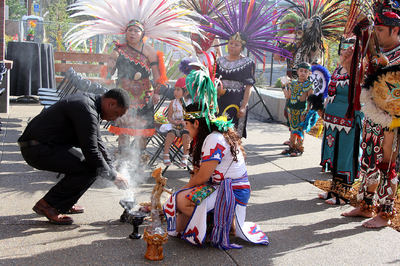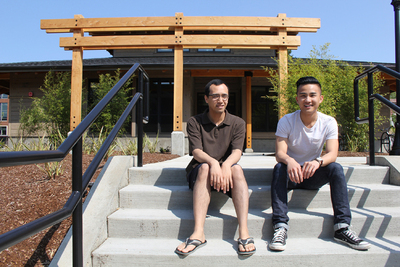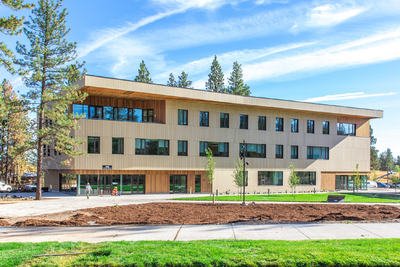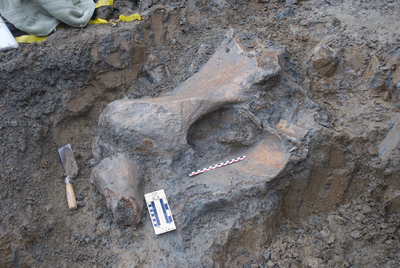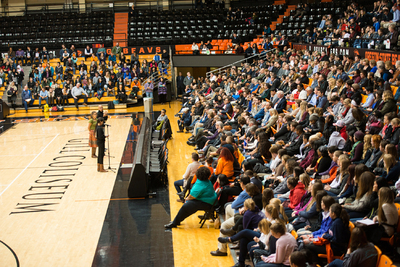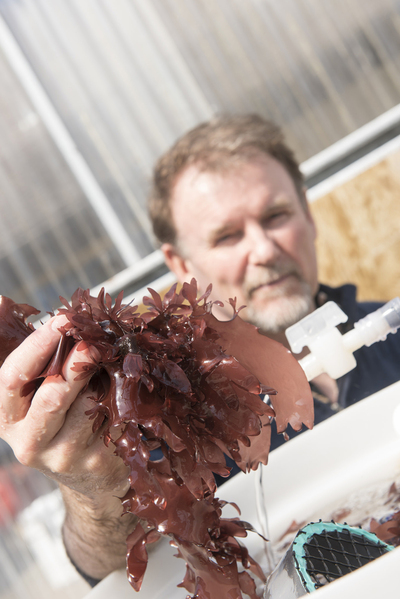2014-2016
2014
The new Centro Cultural Cesar Chavez, the second of four new cultural center buildings, opened on April 7. The 3,565 square-foot building cost $2,521,051 and was designed by Jones & Jones architecture firm of Seattle.
In September, OSU opened its new residence named hall for William "Bill" Tebeau (engineering, 1948). He was a pioneering student who persevered through numerous challenges to become the first African American male to earn a degree from the university. Located south of Wilson Hall, the five-floor, 76,400-square-foot building has a capacity of 324 students and cost $28 million.
In response to acts of racism, students begin the #ITooAmOSU campaign and come together at the Memorial Union Quad on March 9. Students organize the Solidarity March on March 12.
OSU held its 145th commencement on June 14 in Reser Stadium, graduating a record class of 5,878 graduates who received 6,194 degrees.
OSU’s College of Public Health and Human Sciences was granted accreditation on June 24 from the Council on Education for Public Health, making it the first public health program in Oregon to earn that recognition.
More than twenty years after being eliminated due to budget cuts, the religious studies degree program was reauthorized starting with winter term 2015.
In the fall, OSU began offering both a master’s and doctoral degree program in robotics, one of only a few universities in the nation to offer such graduate level programs.
Paul Valenti, an Oregon State athlete, coach, administrator and goodwill ambassador for more than 70 years, died in September. Valenti was an assistant basketball coach (1946-1964) and succeeded A.T. “Slats” Gill as head coach, serving from 1964 to 1970. He also served as an assistant baseball coach, men’s tennis coach (1971-1975) and as associate athletic director.
Jane Lubchenco, Distinguished Professor and Advisor in Marine Studies at OSU and former NOAA administrator, received The World Academy of Sciences Medal at the organization's annual meeting in Muscat, Sultanate of Oman. Lubchenco's award lecture, “Delivering on Science’s Social Contract,” outlined new advances that transform attitudes, behavior, management and policies affecting ocean health.
The Campaign for OSU, the university's first comprehensive fundraising campaign, concluded on December 31. The campaign, launched in 2007, raised $1.14 billion from 106,000 donors representing every state in the U.S. and 50 countries. The gifts included:
- $170 million for more than 600 new scholarships and fellowship funds
- $100 million to help attract and retain leading professors and researchers, including funding for 77 of Oregon State’s 124 endowed faculty positions
- Support for the construction or renovation of more than two dozen campus facilities, including Austin Hall in the College of Business, the Linus Pauling Science Center, new cultural centers, and the OSU Basketball Center.
2015
A $2.6 million expansion of Goss Stadium was completed in January. The project, funded by a lead gift of $1 million from New York Yankees outfielder and former OSU student athlete Jacoby Ellsbury, included a new locker room, updated equipment room, team meeting space, and a rooftop concessions area. The locker room facilities were named for Ellsbury.
The new OSU Lonnie B. Harris Black Cultural Center held a grand opening on April 15. The new facility featured expansive meeting rooms, study spaces and a large kitchen provide plenty of space for all kinds of activities. It was built on the site of the earlier facility, which was moved to another location on campus and repurposed.
OSU's new Asian & Pacific Cultural Center opened April 29, marking the organization's 25h anniversary. The one-story, 3,500 square-foot center was designed by Jones & Jones Architecture of Seattle, which also designed three other new cultural centers on campus.
On May 6, students of color organized a silent protest and march in response to the continued police violence against Black people occurring across the nation and in support of the Black Lives Matter movement.
Although recreational marijuana became legal in Oregon on July 1, it remained illegal on all OSU property under federal law.
OSU history professor Christopher McKnight Nichols was elected to the Council on Foreign Relations, an independent, nonpartisan organization that helps government, civic and religious leaders, business executives, educators and students better understand the world and foreign policy issues. The council, founded in 1921, includes government officials, scholars, business executives, journalists, lawyers and nonprofit professionals.
OSU received a patent for a new strain of a succulent red marine algae called dulse that grows extraordinarily quickly, is packed full of protein and has an unusual trait when it is cooked. The seaweed tastes like bacon.
OSU was rated the third best school nationally by College Factual in its rankings of the "Best Places to Study Natural Resources and Conservation."
Strand Agriculture Hall reopened in the fall after a two-year, $24.9 million renovation project to improve accessibility and install seismic and energy upgrades. A new west entrance, facing the MU quad, was also constructed.
OSU's Learning Innovtion Center (LInC) opened in September. The 134,000-square-foot academic building showcases large-scale, active learning classroom formats, including two arena style classrooms of 300 and 600 seats. A parliament room accommodates 175 students in a room styled after the British House of Commons. The building also was the new home of the University Honors College.
The League of American Bicyclists recognized Oregon State University as a Gold-level Bicycle Friendly University, one of only 12 universities in the United States to have achieved this level.
OSU's fall 2015 total enrollment was 30,592 students, including 24,466 on the Corvallis campus, 1,016 at the Cascades Campus, and 5,110 in Ecampus.
In September several OSU programs received a Bright Spot in Hispanic Education award from the White House for providing underserved Hispanic youth with educational opporunities. OSU's Fiestas, Tech Wizards, Juntos and 4-H Oregon Leadership Institute programs joined more than 230 other programs that received the award.
Corvallis became the first city in Oregon and only the sixth nationally to declare October 12 Indigenous People's Day. The 2015 celebration was held at the OSU Eena Haws Native American Longhouse.
OSU began celebrating Veteran's Day as an official holiday.
On November 16, OSU students held a "Speak Out" event at Gill Collseum at which many described having experienced overt and subtle racism at OSU. The event prompted several changes, including the creation of a position of chief diversity officer; a separate office to provide oversight of Title IX, ADA, affirmative action and equal opportunity issues; and adding student representatives to the OSU Leadership Council on Equity, Inclusion and Diversity.
2016
OSU launched a humanitarian engineering program, one of just ten nationally and the first in Oregon to offer a Peace Corps Master's International program in engineering.
In February, mammoth bones were discovered during the expansion of the Valley Football Center.
Assistant professor of history Christopher McKnight Nichols was chosen as a 2016 Andrew Carnegie Fellow, a prestigious academic fellowship for humanities and social sciences scholars. Nichols was one of 33 scholars chosen out of more than 200 nominees. The award includes up to $200,000 to support research aimed at addressing worldwide challenges to U.S. democracy and international order.
In April, Provost and Executive Vice President Sabah Randahawa was named president of Western Washington University. Randahawa had served as provost since 2005 and had more than 30 years of service at OSU.
The men's and women's basketball teams were invited to play in their respective NCAA basketball tournaments. This marked the first NCAA tourney appearance for the men's team since 1990. They lost in the first round. The women's team made its third consecutive NCAA appearance, and played into the Final Four. They lost to eventual national champion Connecticut, 80-51. The Beavers finished the season ranked No. 2 in the nation, its highest ranking ever.
OSU installed a chapter of Phi Beta Kappa on April 28. The university was awarded chapter of the nation's oldest honor society for liberal arts and sciences after a rigorous three-year application process. OSU was one of three universities awarded out of 26 that had applied.
OSU set a record for research funding for the second year in a row. 2015-16 funding reached the $336 million mark, a 60 percent increase over the past decade.
After closing as OSU's cooperative housing facilities in June 2015, Avery Lodge, Dixon Lodge, Azalea House and Oxford House reopend in summer and fall 2016 with new purposes:
- Avery Lodge -- Human Services Resource Center; Childcare & Family Resources
- Dixon Lodge -- Collegiate Recovery Community
- Azalea House -- Childcare & Family Resources
- Oxford House -- administrative offices for University Housing and Dining Services
In September, OSU Cascades new campus opened with the dedication of Tykeson Hall. It marked the first public university in Oregon to open in more than fifty years. Two additional building under construction on the campus were to open in late 2016 and early 2017 -- a dining/academic building and a residence hall.
In a move designed to make them more inclusive family friendly events, OSU changed its Dads and Moms Weekends to the Fall and Spring Family Weeked. Mom's Weekend dated back to 1924 and Dad's Weekend began in 1934.
OSU's Recreational Sports department celebrated its 100th anniversary. It is the third oldes program of its kind in the U.S. In 2016 nearly 5,000 people used the Dixon Recreation Center daily.
In April the OSU Libraries and Press presented its 2016 Linus Pauling Legacy Award to OSU faculty member and former NOAA administrator Jane Lubchenco. She was the first female and first OSU faculty member to win the award.
In the fall, an expanded and updated Valley Football Center opened after nearly a year under construction. The $42 million project added 55,000 square feet to benefit student athletes in 17 sports. New facilities included a new home team locker room, meeting spaces, expanded sports medicine facilities and equipment area, renovated north end zone seating, and a new building entrance.
Johnson Hall opened in the early fall. The 60,000 square foot, $40 million building, adjacent to the Kelley Engineering Center, houses the School of Chemical, Biological, and Environmental Engineering. It includes research labs, teaching space and faculty offices. It was named for Peter ('55, chemical engineering) and Rosalie Johnson, longtime supporters of the College of Engineering.
In October, the OSU band program celebrated its 125th anniversary. The band, the oldest in the Pac-12 conference, was established in late 1891 with a handful of male students. Today OSU's band program is one of the largest in the Pacific Northwest.

